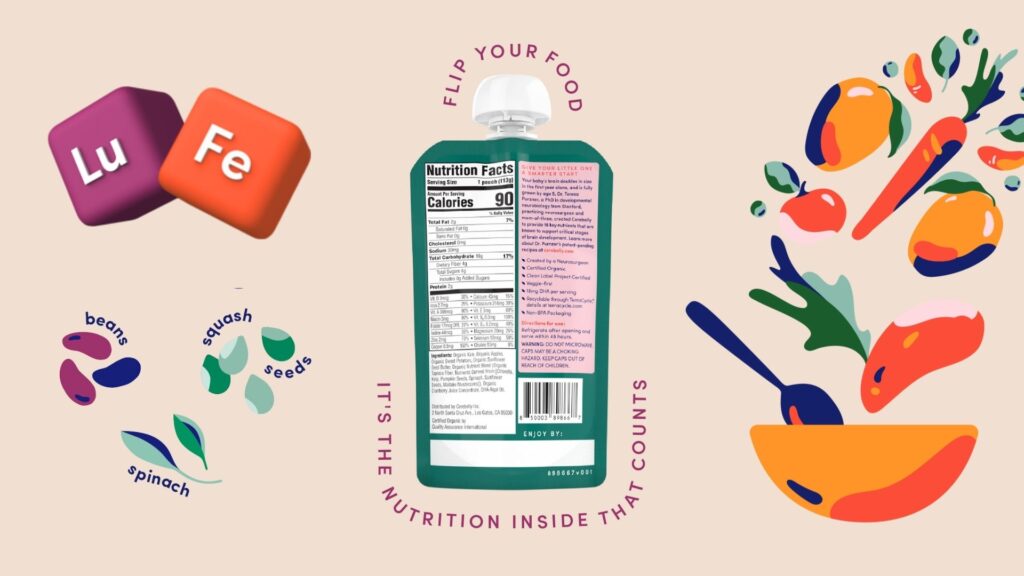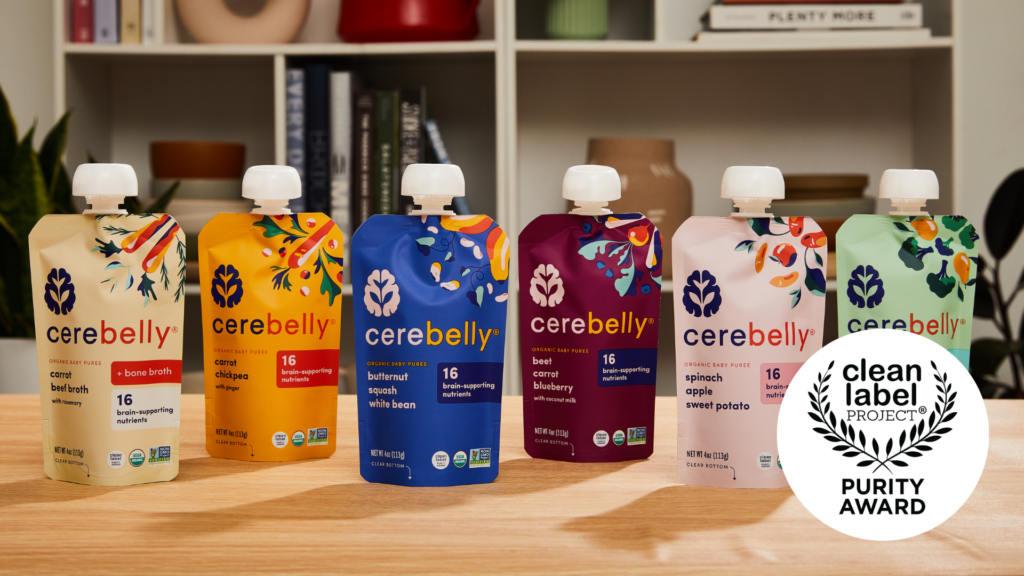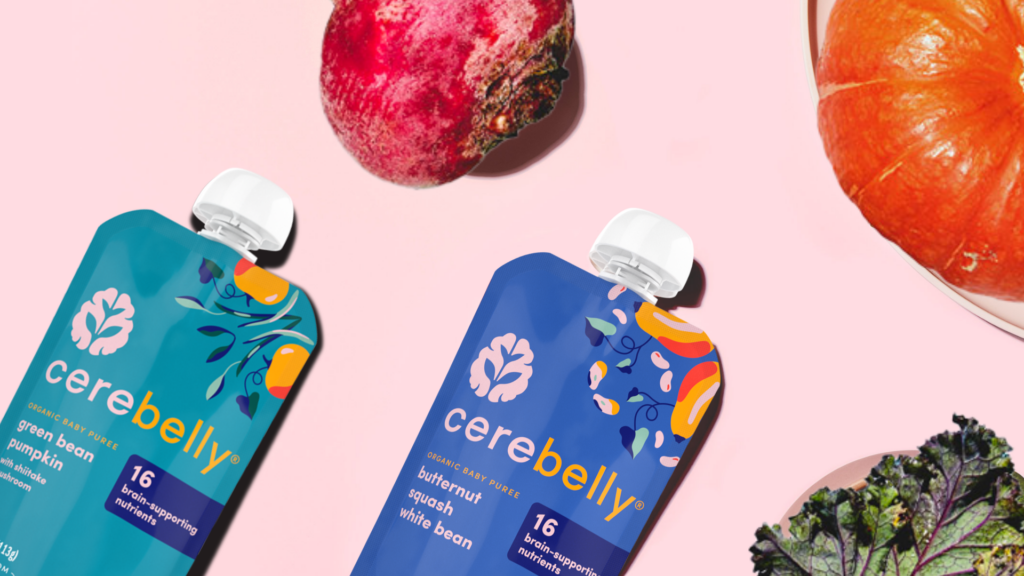Why Veggies as a First Ingredient?
The first ingredient on a food label’s ingredient list is the one present in the highest amount. It is important to be aware of this because food packaging can be misleading.
If you look closely at the ingredient list of various baby food purees, you will find that many packaged baby purees will use fruit (such as apple puree) as a first ingredient, for a sweet taste. While there is nothing inherently wrong with serving fruit to your child, it should not be the main ingredient in a meal.
The ‘food label ingredient list’ is your BEST indicator of how nutrient dense a baby food puree is.
This article will help you understand why vegetables as a first ingredient in baby food are so important.

What to look for on the ingredient list:
1. Look at the first few ingredients
As mentioned above, the first ingredients are the ones present in the highest quantity. Do not be fooled by a product that has a nutrient dense veggie in the name or pictured on the package.
If that ingredient is not in the first three ingredients, it’s not present in a meaningful amount.
2. Look for a nutrient-dense vegetable or legume as the first and second ingredient
A nutrient dense food is one that contains a wide variety of nutrients, such as protein, complex carbohydrates, fiber, and vitamins/minerals.
Vegetables that have a deep hue, like dark green, orange, purple or red, have a high nutritional value.
Examples of nutrient dense legumes are beans, peas, and chickpeas.
Why Vegetables and Legumes
Better nutrition
Veggies and legumes are awesome, instead of fruit, as a first ingredient in baby food. Dark green and orange veggies are especially good choices because they contain nutrients such as iron, lutein, and beta carotene.
When talking about infant nutrition, one of the most important points to consider is the inclusion of iron rich foods. Both plant-based and animal-based iron sources are recommended to start at 6 months of age.

Plant-based iron sources – beans, peas, lentils, chickpeas, spinach, tofu. Animal-based iron sources – meat, egg yolk. Note: iron in meat is absorbed in the body most readily.
Legumes are also rich in protein, which babies need for brain development and whole body growth.
Vegetables pair well with sources of fat
Veggies pair well with a variety of healthy dietary fat choices, which is hugely important for infant brain development and whole body growth.
Each meal for your baby should include a source of fat. Combining veggie and legume purees with fat sources is easy. Try avocado oil, olive oil, flaxseed oil, sunflower seed oil, butter, ghee, cream, avocado or high fat yogurt.
Babies have extraordinary energy needs, as they are growing FAST. Dietary fat provides more than two times that amount of energy (calories), compared to carbohydrates and protein. It also helps the body absorb certain important vitamins, such as vitamins E, D, A and K.
Want to learn more about these nutrients and where to find them? Check out this article that defines 16 key nutrients for growing minds.
5. Vegetables provide energy (calories) coming from protein and complex carbohydrates
When veggies and/or legumes are the first ingredients, you get calories from protein and complex carbohydrates. On the other hand, a fruit-based puree provides calories almost exclusively from natural sugars, and have an overall low nutrient value.

Taste and Food Acceptance
The toddler years (2-5years) are full of stressful parenting moments when kids commonly develop food neophobia. This is the avoidance of trying new foods. It’s likely the main reason that 90% of toddlers fall short on their daily vegetable intake (1).
We know that offering bitter tasting green vegetables early and often, from the time you first begin offering solids, is helpful to familiarize your child with these foods as they approach the toddler years.
Baby’s taste preferences for bitter and bold tastes can be learned with repeated exposures. Offering veggie-first purees is a great start. But don’t stop there. Once your little one is trying different textures and expanding their variety with all sorts of new foods, don’t forget to continue to offer veggies often to keep those tastes familiar!
You can keep up your ‘veggie goals’ by mixing veggie-first purees into sauces for pasta, or heat them up with broth or coconut milk for an easy & nutritious soup.
There are so many ways to incorporate (not hide!) these nutrient dense ingredients to prepare kids for a lifetime of healthy eating.
References:
- Dietary Guidelines for Americans 2020-2025. USDA. dietaryguidelines.com
About
the author
Stacey Segal BScA, MSc, RD

Stacey is a pediatric dietitian and a mom of two little eaters. Her career has been dedicated to nourishing babies, toddlers and kids. She’s a staff dietitian at The Hospital for Sick Children, Toronto, specializing in neuroscience. Stacey is also the founder of the Prenatal and Pediatric Nutrition Clinic at GSH Medical, and a nutrition writer for AboutKidsHealth website. Being a mom herself, she has experienced the challenges that come with feeding kids. She’s passionate about helping families raise well nourished kids right from the start!
Have more questions? Send us an email at support@cerebelly.com and we will be sure to get back to you!



